Barbie and the Bild Lilli Doll
Since her inception in 1962, Barbie has been specifically marketed to girls as a “teen-age fashion model.” She was revolutionary because she was the first doll created for children that was not itself a child. Barbie is an aspirational toy for girls, an idea of themselves older and brimming with confidence. And with a fantastic wardrobe. When Barbie was created, she closely resembled another doll with a very different backstory…
From 1952 to 1961, the German tabloid Bild ran a comic strip called “Lilli”. Lilli was a beautiful young woman with blond hair pulled back into a high ponytail, face accented by a single curl in the center of her forehead.
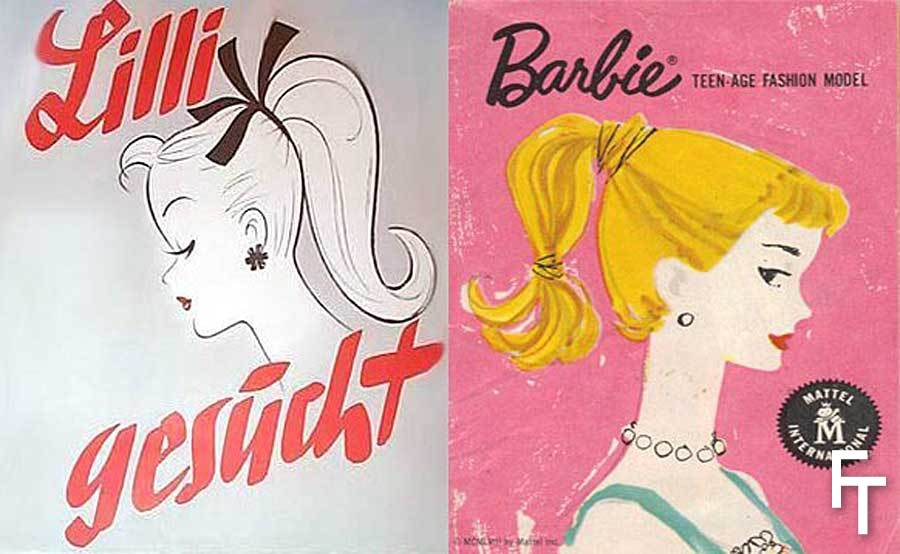
In each comic, Lilli is the focus of the single panel and is often dressed in revealing clothing, or disguising her nudity behind some conveniently placed object. I don’t speak German, but by cobbling together other sources and using Google translate, I am quite sure Lilli lives a lavish life funded by her many boyfriends. Her looks and wit get her into-and out of-many amusing situations.
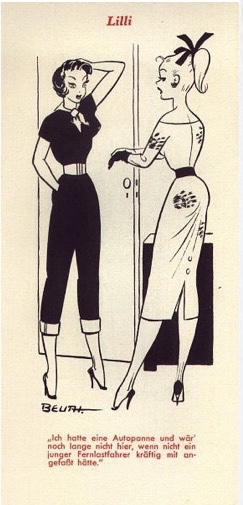
Lilli frequently laments that no one is looking at her when she is wearing skimpy clothing. She knows she is beautiful and refuses to keep her beauty to herself.
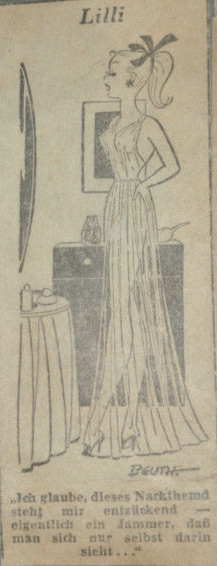
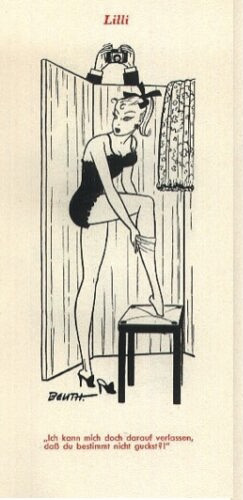
Always sexy and clever, Lilli in the comic strip was frequently involved with and supported by wealthy men. Although a few comics portray her in an office job:
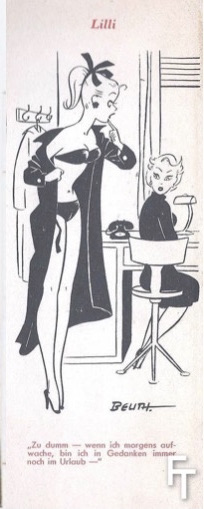
She is usually leaving or arriving, but rarely actually doing the job, whatever it may be. Her main focus is to look and dress beautifully and be admired while doing it. Her expansive wardrobe is certainly not within the reach of a secretary (?) in her 20s, and some comics outright state that her lifestyle is funded by her romantic partners.
In one she appears at a friend’s door covering her naked body with a newspaper, saying “We had a fight and he took back all the presents he gave me.”* If she was not an outright sex worker, Lilli was assuredly a well-kept woman who relied on her boyfriends to support her lifestyle.
The Lilli comic was so popular that in 1953 the tabloid launched a doll version of her. Around 130,000 were made between 1953 and 1964, at which point the Mattell company bought the rights to the character and Lilli was discontinued. As a doll she was an extremely popular “gag” gift for men both in Germany and internationally. One German advertisement for Lilli stated that she was “always discreet” and “the star of every bar.”** Bild even sold a Lilli swing to attach to a rearview mirror, so Lilli could swing while you drove.

Although I love the fact that a character who may have been a sex worker existed and inspired Barbie, Lilli was not particularly three-dimensional. Some scholars have decried Lilli as a “sex doll”*** and a “sex toy”****, and argue that she is only a caricature of a man’s idea of the perfect woman.
Lilli was certainly a product of her time and is not a particularly flattering depiction of women or sex workers by contemporary current standards. But I think she was more than a sex toy. Operating within the bounds of femininity in the 1950s, Lilli the character had a happy life. She used her charms to get what she desired, without being shamed for the way she chose to live.
*Referenced by M.G. Lord in Forever Barbie: The Unauthorized Biography of a Real Doll. I have been unable to find an image of the exact comic.
**https://theamsterdamtoymuseum.com/bildlilli
*** Ariel Levy, Female Chauvinist Pigs
**** Eve Ensler, https://theamsterdamtoymuseum.com/bildlilli
